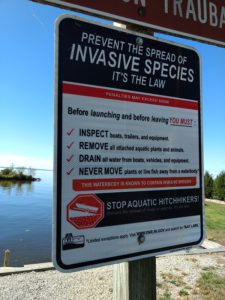Every month, we will put a spotlight on an aquatic invasive species (AIS) in a re-occurring monthly article. Check it out! This month, we highlight an invasive species that is in the Great Lakes: quagga mussels!
Quagga Mussel
Native to the Caspian Sea, quagga mussels (Dreissena bugensis) were introduced to the Great Lakes in the same way as zebra mussels – in ballast water of  trans-oceanic ships. Quagga mussels were first recorded in 1991 but analysis of the populations in the Great Lakes indicates that quagga mussels established earlier than zebra mussels. The mussels have established in all the Great Lakes but have not been found to the extent of zebra mussels in other inland waterbodies. Quagga mussels tend to prefer cooler and deeper habitats, which may help explain why quagga mussels haven’t invaded as many inland lakes as zebra mussels. Even in the Great Lakes, some parts of the lakes are dominated by zebra mussels while quagga mussels dominate in other areas which might be due in part to the difference in habitat preferences.
trans-oceanic ships. Quagga mussels were first recorded in 1991 but analysis of the populations in the Great Lakes indicates that quagga mussels established earlier than zebra mussels. The mussels have established in all the Great Lakes but have not been found to the extent of zebra mussels in other inland waterbodies. Quagga mussels tend to prefer cooler and deeper habitats, which may help explain why quagga mussels haven’t invaded as many inland lakes as zebra mussels. Even in the Great Lakes, some parts of the lakes are dominated by zebra mussels while quagga mussels dominate in other areas which might be due in part to the difference in habitat preferences.
Quagga mussels live in freshwater waterbodies such as lakes and rivers. They do not tolerate salinity well but can tolerate salinities up to 5‰. The mussel tends to start dying above water temperatures of 82.4°F and thus prefers habitat that is deeper and colder than zebra mussels. Quagga mussels have been found in over 420 feet of water! One of the most concerning features of the quagga mussel is its ability to survive on both hard and soft surfaces such as sand. Zebra  mussels can only attach and survive on hard surfaces. Being able to inhabit soft surfaces means a larger area that can potentially be colonized in lakes and rivers by quagga mussels. Quagga mussels are about the same size as zebra mussels (~2 inches) and can have similar shell patterns. The easiest way to distinguish between the two mussel species is the difference in shell shape. If you place a quagga mussel on its ventral side, it will topple over as its ventral side is rounded. A zebra mussel will not tip over as its ventral side is flat.
mussels can only attach and survive on hard surfaces. Being able to inhabit soft surfaces means a larger area that can potentially be colonized in lakes and rivers by quagga mussels. Quagga mussels are about the same size as zebra mussels (~2 inches) and can have similar shell patterns. The easiest way to distinguish between the two mussel species is the difference in shell shape. If you place a quagga mussel on its ventral side, it will topple over as its ventral side is rounded. A zebra mussel will not tip over as its ventral side is flat.
The impacts of the quagga mussel mirror the impacts that zebra mussels cause on waterbodies. However, the impacts of quagga mussels are more extreme due to their ability to colonize sand and mud in addition to hard surfaces while also inhabiting deeper and colder water habitats. Similar to zebra mussels, quagga mussels are filter feeders meaning they filter water to eat algae and other plant material floating in the water. They can substantially remove some species of algae from waterbodies that is the base of the aquatic food web. With less floating material in the water, sunlight reaches new areas of the lake that can change the area rooted aquatic plants can grow. The feces created by quagga mussels also puts more nutrients into the water that allows species of phytoplankton that these mussels don’t eat to bloom (such as blue-green algae). Just like with zebra mussels, boating, fishing and other recreation can be negatively impacted by quagga mussels as they can attach to hard surfaces such as boats, water intake pipes, and docks. Millions of dollars are annually spent to remove quagga mussels from clogged water intakes and other surfaces that are covered with mussels.
Quagga mussels are Prohibited in all Wisconsin counties.
Want to help? HELP PREVENT THE SPREAD!
Every time you come off the water, make sure to follow these steps to stop the spread of faucet snails and other aquatic invasive species:
* Inspect boats, trailers, push poles, anchors, and other equipment for attached aquatic plants or animals.
* Remove all attached plants or animals
* Drain all water from boats, motors, livewells and other equipment
* Never move live fish away from a waterbody
* Never release aquarium plants or animals into your local waterways
Follow the Fox Wolf Watershed Alliance’s Winnebago Waterways Program on our Winnebago Waterways Facebook page or @WinnWaterways on Twitter! You can also sign-up for email updates at WinnebagoWaterways.org.
Questions? Comments? Contact Chris Acy, the AIS Coordinator for the Winnebago Waterways Program covering Fond du Lac, Calumet, and Winnebago Counties at (920) 460-3674 or chris@fwwa.org!
Winnebago Waterways is a Fox-Wolf Watershed Alliance program. The Fox-Wolf Watershed Alliance is an independent nonprofit organization that identifies and advocates effective policies and actions that protect, restore, and sustain water resources in the Fox-Wolf River Basin.
Photo Credit: John Karl, Minnesota Sea Grant, Russel Cuhel, Ashley Elgin, NOAA, GLERL, Chris Acy
